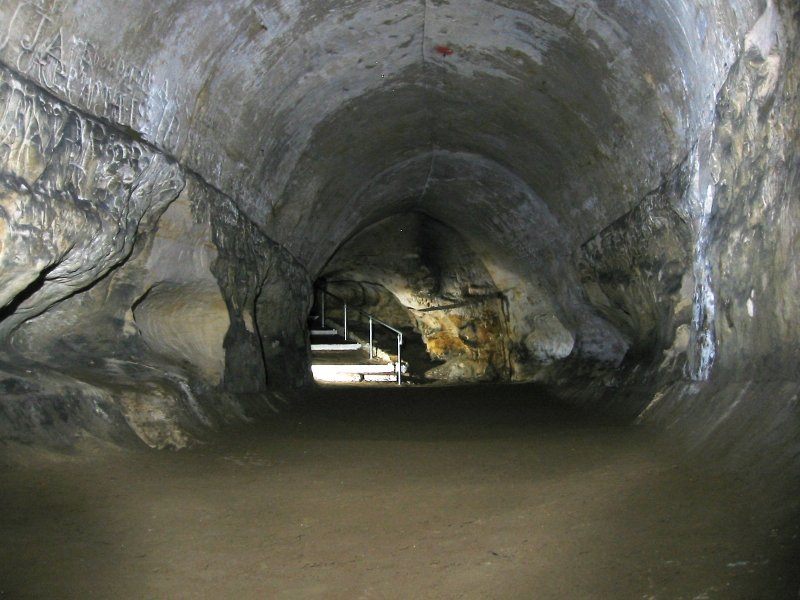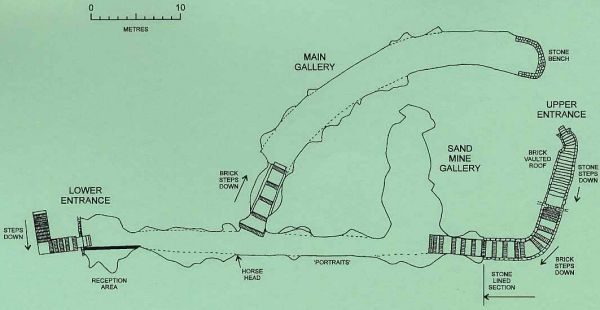THE BARONS’ CAVE

There have been many ideas put forward to explain why the cave was dug. It is very unlikely that it was the castle dungeon. The quality of workmanship also rules out the idea that it was just the castle cellar, or a sand mine. The through passage could have been dug as a sally port, which is an escape tunnel to allow the besieged inhabitants to surprise their attackers, or to escape unnoticed. This does not explain why the large side passage was dug.
The effort and skill used to dig The Barons’ Cave, and the size of its galleries, suggest that it was a special and important feature of the castle. The story which gave rise to the name “Barons’ Cave” is that the barons met there to draw up the Magna Carta in 1215, before making King John sign it. Unfortunately, this is a romantic story that is certainly not true.
Nobody knows how exactly old the Barons’ Cave is. The oldest reference to it dates from 1586 when Camden describes “an extraordinary passage with a vaulted roof hewn with great labour out of the soft stone.” Doors and windows with a similar profile to the cave passages were being built from about 1200 onwards, but we must be careful before drawing any conclusions from this.
In the centuries that followed the cave was almost certainly accessed for sand with the rough side passage probably dug in the 19th century by sand diggers, who were also active elsewhere in Reigate at that time. Throughout the cave, the work of sand diggers can be seen. Many alcoves have been dug into the otherwise well-shaped walls. The walls of the cave have attracted graffiti artists. Apart from the many initials, names and dates from 1644 onwards, a number of other carvings have been made. The most notable of these are a series of large heads, each one unique, and possibly meant to depict real people. There are also a number of horses’ heads and a bull’s head to be found in the cave.
The cave has a long history as a local curiosity. The earliest account of guided tours found so far dates from 1860, when a lady from a nearby cottage had to be summoned to conduct curious visitors around the cave. Visits continued until the 1970s, with the Castle Grounds’ gardener acting as guide. In 1991, the Wealden Cave and Mine Society reopened the caves for the public after a period of restoration.
CASTLE HISTORY
The Barons’ Cave is one of Britain’s oldest show caves. It is part of the old Norman castle, which was demolished many years ago, and is one of Reigate’s oldest surviving medieval features.
The castle was probably built by the second Earl of Surrey, William de Warrenne, soon after 1088. This castle consisted of a central mound surrounded by a dry moat, with timber buildings and defences on the mound, or motte. In the 12th or 13th century, the timber structures were replaced with stone ones. The castle was extended to the north and east by the creation of the outer ward, or outer bailey, the original mound being the inner bailey. This new addition to the castle was protected by a new wet moat, part of which survives, and by an extension of the existing dry moat.
During the time of Oliver Cromwell, the castle was briefly garrisoned by followers of a Royalist uprising in 1648, and then by parliamentary troops after the insurrection had been put down. There was no fighting at the castle, it was just a convenient camp for the troops.
The castle started falling into disrepair in the 16th century and now none of the original castle buildings remain, with the exception of the Barons’ Cave. In the 18th century, the Castle Grounds were “tidied up” and the mock gateway was built. It may have been when the caves were opened up for curious visitors, as there are very few dates to be found in the cave from before 1770.
The guided tour (by one of our experienced volounteer guides) lasts around 30 to 45 minutes, depending on the size of the group.
Details of the history and preservation of the cave will be given and your guide will be happy to answer any questions.
